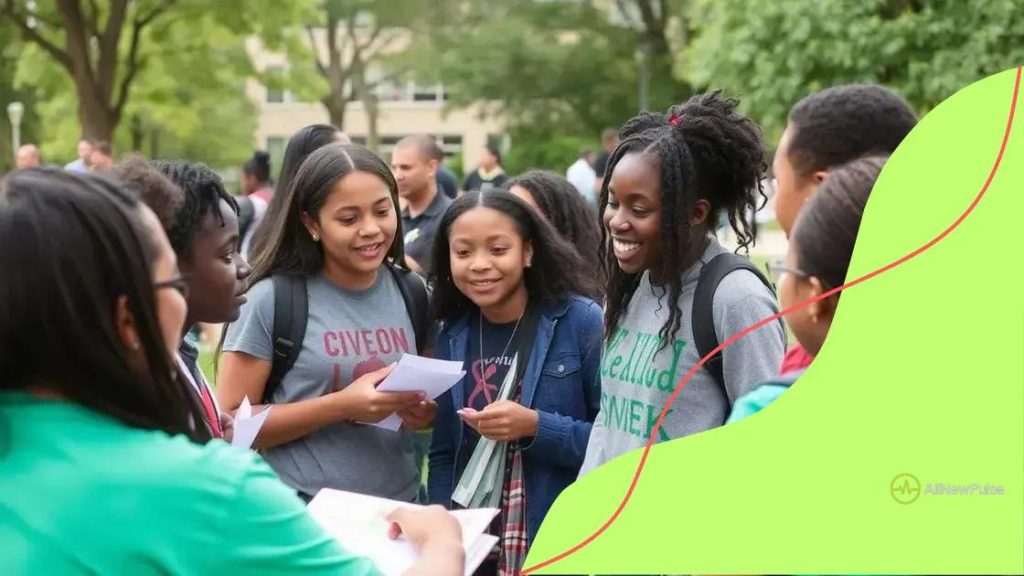Promoting civic engagement through education: a guide

Promoting civic engagement through education involves equipping students with the knowledge and skills to participate actively in their communities, fostering informed citizenship and lifelong involvement in democratic processes.
Promoting civic engagement through education is essential for building strong communities. Have you ever thought about how your local school can inspire active citizenship? Let’s explore.
Understanding civic engagement
Understanding civic engagement is vital for fostering a healthy democracy. At its core, civic engagement is about the ways individuals participate in their communities and influence decision-making. It’s more than just voting; it encompasses volunteering, advocacy, and community service.
What is Civic Engagement?
Civic engagement refers to the active participation of individuals in the life of their community. It involves being informed about local issues and contributing to discussions that shape public policy. When people are engaged, they can express their views, advocate for change, and hold their leaders accountable.
Benefits of Civic Engagement
- Strengthens community bonds
- Enhances individual well-being
- Encourages diverse perspectives
- Demands accountability from leaders
People who engage in civic activities often report feeling more connected to their community. This participation can lead to stronger support networks and a better quality of life. Moreover, when diverse voices come together, they enrich discussions and promote inclusivity.
Education plays a key role in promoting civic engagement. Schools can teach students about their rights and responsibilities, encouraging them to take an active role in their democracy. Programs that involve students in community projects can help bridge the gap between academic learning and real-world application.
Understanding civic engagement also involves recognizing the barriers that prevent people from participating. Some may feel their voices won’t matter, while others lack access to resources or information. Identifying these challenges is the first step toward making civic participation more accessible to everyone.
How to Foster Civic Engagement
- Encourage open discussions about community issues
- Provide resources for civic education
- Create opportunities for volunteering
- Organize community events that welcome participation
Ultimately, building a culture of civic engagement requires effort from everyone. By promoting awareness and providing support, we can encourage more people to become active participants in their communities.
The role of education in civic engagement
The role of education in civic engagement is critical for nurturing informed and active citizens. Education provides the knowledge and skills necessary for individuals to participate meaningfully in their communities. When students learn about their rights and responsibilities, they are more likely to engage in civic activities.
Empowering Through Knowledge
Education empowers individuals by providing them with a clear understanding of governmental processes and societal issues. This knowledge equips them to recognize how decisions affect their lives and encourages them to voice their opinions. Students who are informed are more likely to become active participants in their local governments.
Creating Opportunities for Participation
- Service-learning programs connect classroom learning with community needs.
- Debate clubs foster critical thinking and discussion of current events.
- Leadership programs develop skills necessary for advocacy.
- Field trips to local government offices expose students to civic processes.
By incorporating these opportunities into curriculums, schools can create a culture of engagement. These experiences help students connect their education with real-world applications, making learning more relevant.
Moreover, civic education shouldn’t stop in the classroom. Schools can partner with local organizations to create engaging programs that encourage students to volunteer. When students see their efforts lead to positive outcomes, their belief in civic involvement strengthens.
Educators also play a crucial role in shaping attitudes towards civic engagement. By fostering open discussions about controversial topics, teachers can help students learn to articulate their views respectfully. This not only prepares them for civic participation but also for life beyond school.
Measuring the Impact of Education on Civic Engagement
- Surveys can assess students’ understanding of civic issues.
- Participation rates in school activities can indicate levels of engagement.
- Community feedback can provide insights into the effectiveness of educational programs.
- Tracking alumni can show long-term civic involvement.
Monitoring these metrics helps schools recognize the impact of their efforts and refine their approaches. Continuous improvement in civic education can maximize its potential to empower future citizens.
Innovative educational programs promoting civic involvement

Innovative educational programs promoting civic involvement are essential for creating engaged citizens. These programs help students connect the lessons they learn in school with real-world civic engagement. Schools across the country are finding creative ways to encourage students to participate in their communities.
Types of Innovative Programs
Many schools have adopted programs that go beyond traditional teaching methods. These programs often involve hands-on experiences that show students the importance of their role in society. For instance, service-learning projects enable students to work on community issues while developing valuable skills.
Examples of Successful Programs
- Community gardening projects that enhance local food security.
- Mock elections that teach students about the voting process.
- Partnerships with local nonprofits to address social issues.
- Student-led advocacy campaigns on topics they care about.
These initiatives not only promote civic engagement but also foster teamwork and leadership among students. When students work on projects that matter to them, they are more likely to stay engaged and take ownership of their education.
Moreover, digital platforms play a significant role in connecting students with civic opportunities. Online resources can help students learn about local government, upcoming elections, and advocacy groups. Many schools are integrating technology into their programs, allowing students to research and present their findings creatively.
Engagement Through Collaboration
Collaboration between schools and community organizations is key to enhancing civic involvement. By partnering with local groups, schools can provide students with opportunities to engage in real-world issues. These partnerships can offer internships, workshops, and events that give students hands-on experience.
When students learn how to navigate civic structures, they develop a sense of agency. They begin to see themselves as active participants, shaping the communities in which they live. Innovative programs nurture this sense of agency, preparing the next generation to be informed and engaged citizens.
Community initiatives to enhance civic participation
Community initiatives to enhance civic participation are vital for building strong, engaged neighborhoods. These initiatives encourage residents to get involved and have their voices heard. When communities work together, they can tackle challenges effectively and promote positive change.
Types of Community Initiatives
Many communities have launched programs aimed at increasing civic engagement. These initiatives often focus on collaboration and inclusivity, making it easier for everyone to participate. Examples include town hall meetings, community forums, and workshops that provide information on local issues.
Success Stories
- Neighborhood watch programs that raise awareness about safety.
- Local clean-up efforts that beautify public spaces and unite residents.
- Voter registration drives that simplify the process for community members.
- Public art projects that reflect community values and history.
These success stories showcase how communities can come together for positive impact. When individuals feel their contributions matter, they are more likely to engage in civic activities.
Furthermore, leveraging technology can enhance participation. Many communities are now using social media to spread the word about initiatives and gather input. Online platforms can serve as a forum for discussion, allowing residents to share their ideas and feedback.
Promoting Inclusive Participation
Inclusivity is essential for effective community initiatives. It is crucial to ensure that everyone, regardless of background, can participate. This can be achieved through outreach efforts, such as multilingual materials and accommodations for those with disabilities. When all voices are included, the initiatives reflect the true needs of the community.
Engaging young people is also important. Schools and youth organizations can collaborate on projects that promote civic involvement. Programs that allow students to take the lead foster a sense of responsibility and encourage them to become active citizens.
Measuring the impact of civic education
Measuring the impact of civic education is essential to understand how well programs foster active participation among students. Effective civic education equips young people with the knowledge and skills they need to engage in their communities. Evaluating its impact helps educators refine their approaches and demonstrate value to stakeholders.
Methods of Measurement
There are various ways to measure the effectiveness of civic education. Surveys and assessments can gauge students’ understanding of civic concepts. Additionally, observing participation in civic activities can provide insight into whether students are applying what they’ve learned.
Key Metrics to Consider
- Student participation rates in community events.
- Surveys assessing knowledge of civic rights and responsibilities.
- Feedback from teachers about student engagement.
- Long-term tracking of students’ involvement in civic activities post-graduation.
Using these metrics, educators can identify strengths and areas for improvement in civic programs. For instance, if survey results show low understanding of basic rights, this indicates a need for more focused lessons in that area.
Another effective measurement tool is the analysis of community impact. Schools can track how many students take part in voter registration drives or local elections. This real-world application is an excellent indicator of the program’s effectiveness.
The Role of Feedback
Gathering feedback from students and the community enhances the measurement process. Students can share their experiences through focus groups. This qualitative data helps educators understand how civic education shapes students’ attitudes and behaviors.
Community partners can also provide insights into student involvement. By working closely with local organizations, schools can receive valuable feedback on how well students are prepared for civic engagement outside the classroom.
FAQ – Frequently Asked Questions about Civic Education
What is civic education?
Civic education teaches individuals about their rights, responsibilities, and the importance of participating in the democratic process.
How can we measure the impact of civic education?
The impact can be measured through surveys, student participation rates in civic activities, and feedback from both students and communities.
What are some examples of civic education programs?
Examples include service-learning projects, mock elections, and partnerships with local organizations to tackle community issues.
Why is community involvement important for civic education?
Community involvement helps students apply their knowledge in real-world situations, fostering a sense of responsibility and encouraging lifelong civic engagement.





